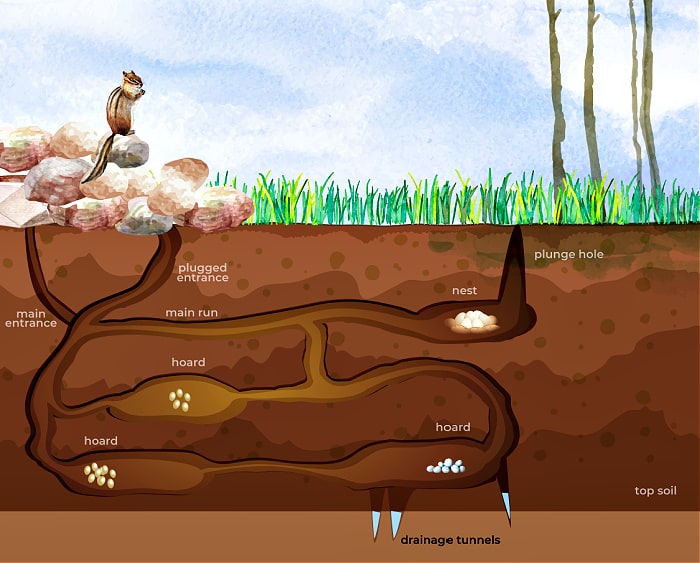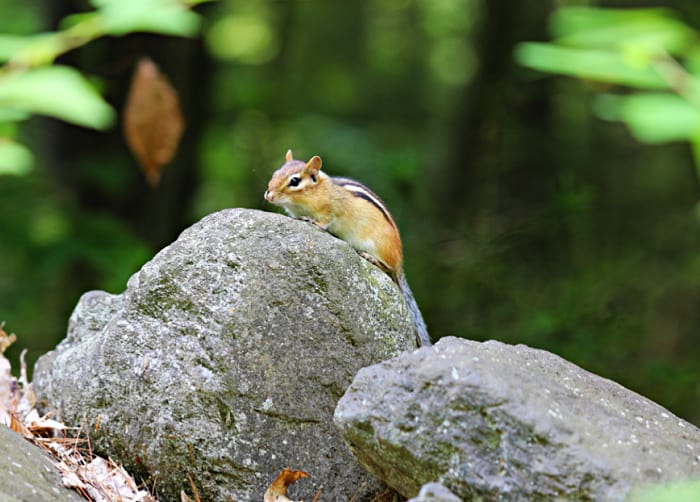Learn how to get rid of chipmunks and prevent them from coming back. These methods and products are the best way to keep chipmunks from destroying landscape plants and vegetables.
Chipmunks are a little bit of everything. Quick, clever, cute, curious, and playful. At least those are the good attributes. They can also be very destructive and an overall nuisance around your home and landscape.
Chipmunks are very active in Spring, Summer, and Fall. They usually breed twice during the year. Once in spring and another time in summer. As fall approaches they spend extra attention hoarding food so they can have enough reserves during the winter months. During the winter they spend most of their time in their sophisticated inground tunnels which can reach 30 feet long. These tunnels act as places to store food, nest, hide, and stay protected during the winter months. Take a look at a typical tunnel system below:

These underground systems will be less significant or non existent if there are other places to live such as rock walls, wood piles, or brush. That is why it is common to see chipmunks in your landscape surrounding your home.
These small, striped rodents, feed on spring flowering bulbs, herbs, vegetables, berries, nuts, plant leaves, flowers, and worms. For the gardener trying to grow a viable crop or maintain healthy plants, these little guys can be a nightmare.
Luckily there are plenty of prevention and removal options that are effective in keeping these creatures away from your home, plants, and garden beds. The good news is, it’s very rare to have a chipmunk problem inside your actual house since they prefer to stay outside.
How to Get Rid of Chipmunks (No Kill Methods)
1. Use protective bird netting
This is one of my favorite ways to prevent chipmunks in my vegetable garden. I use 1/4” protective netting, and drape it over my raised veggie beds. I’ll actually take some 2×4’s that are about 4′ tall and stake a couple into the middle of the garden beds. This way I can lay the bird netting over the 2×4’s and it wont get tangled up in my tomato plants, melons, or whatever else I’m trying to grow. These nets also prevent wood chucks, rabbits, deer, and other animals from ruining your vegetables. I highly recommend this option for the vegetable garden since it is economical and by far the most effective.
2. Keep woodpiles away from house and garden beds
Chipmunks love living in woodpiles. The little voids left from stacking wood are perfect spaces for them. Move wood piles away from your home and garden beds or consider storing wood in a fire wood storage box.
3. Cleanup brush
Think of a brush pile as a hotel for chipmunks. Cleaning up brush around your house is a very simple way to deter chipmunks.
4. Relocate or get rid of bird feeders
There’s no doubt that chipmunks will notice your bird feeder. Even if they can’t get into the actual feeder they will feed off of scraps that birds leave behind. If you insist on having a bird feeder try and designate a place for it away from your home and garden beds.
5. Install mesh fencing or netting
This is another great idea for the vegetable garden. You can even use bird netting to create a fence around vegetable plants. Use wooden garden stakes and zip ties to fasten the netting. For added protection dig the netting into the ground 6” deep and create an L shape in the ground. This will prevent chipmunks from getting underneath the netting. Just try to keep the holes in the fencing 1/2” or less.
6. Use chipmunk repellent
There are a lot of rodent repellents out there that offer mixed results. But for chipmunks, I’m a big fan of Cridder Ridder Animal Repellent, by Safer Brand. You simply shake out the granules which contain a dual action formula to repel rodents by scent. The best part is the granules are safe to use in and around your home, landscape, and vegetable garden since they are organic. This makes it a great choice for use around sheds, garages, or anywhere along your house where you are concerned with kids or pets coming into contact.
7. Plant bulbs under 1/2 inch hardware cloth
Installing 1/2” Hardware Cloth over your bulbs right after you plant them is a great way to protect bulbs from being eaten by chipmunks and other rodents. Simply plant bulbs in the ground as you normally would. Cover the bulbs with a couple of inches of soil, then lay down the hardware cloth so it extends at least a foot past the bulb or bulbs, on all sides. Then cover the hardware cloth with the remaining soil. This will allow the bulbs to grow up through the hardware cloth but it will prevent chipmunks from being able eat the bulb and root portion of the plant.
8. Spray plants and vegetables with pepper
Chipmunks don’t like the taste of hot peppers. Spraying foliage, especially in your vegetable garden, can be a great way to deter chipmunks. There are a lot of easy homemade pepper spray recipes out there. One simple pepper spray recipe for chipmunks is to add 2 tbs. of ground cayenne pepper to 1 quart of boiling water. Allow the mix to cool and then pour it into a spray bottle.
9. Plant Daffodils, Hyacinths, and Allium
If planting bulbs, consider planting Daffodils, Hyacinths, and Alliums since these bulbs are not appealing to chipmunks.
10. Use a combination of strategies
Since no one solution is close to perfect, try implementing a combination of the strategies above to prevent chipmunk damage in your yard and garden.
How to Get Rid of Chipmunks (Kill Methods)
Although rare, there might come a time where chipmunks become such a nuisance that kill traps are required. There are a lot of chipmunk kill traps and poisons out there but personally I find the most humane and effective trap to be the Tomcat Snap Trap. Simply follow the instructions that come with the trap and use peanut butter for the bait.
Can You Relocate Chipmunks?
You may be familiar with cage traps that safely trap the animal so you can relocate them. These traps are heavily marketed as the most humane way to get rid of chipmunks on your property.
Unfortunately, studies have shown that the majority of relocated animals actually face a slow death in their new habitat. People are quick to underestimate how territorial most animals are, especially chipmunks. They spend most of their lives in a designated location where they can find and store food, build shelter, nest, and raise their young.
In a new habitat they struggle to adapt quick enough. Ultimately they end up starving to death, or falling to predators or the weather elements. The harsh reality is these animals are likely to face a more humane death from a snap trap.
Check Out These Posts Next
The Conifer Seed Bug: Identify, Prevent, and Remove
White Grubs: Prevention and Treatment
Japanese Beetles: Control and Prevention
How to Install Landscape Fabric
Follow Me
Join my free email list!
Plus, follow me on Facebook, Instagram, and Pinterest.



How do I get rid of little brown worms they are getting in my house and have to pick them up or vacuum them up it’s a pain seeing them every day
Hi Patricia… I bet the little brown worms are actually millipedes or centipedes. If that is the case I would continue to vacuum or sweep them up. Eventually they will die anyway since they prefer damp environments and usually dry up once inside homes. I had a large infestation in a condo complex I was working on awhile back. Everyday I’d sweep the parking garage where most of them were concentrated. Within weeks they were mostly gone. My theory was that they got into some mulch that was delivered a couple of weeks prior. In the meantime you could also use ‘Orthos Home Defense Insect killer Indoor Outdoor Perimeter’ to create a barrier around your house, especially your basement.
Moss & Mushrooms
Mark, what do you recommend to fight Moss and Mushrooms, Every year I have both of these problems, in my otherwise attractive lawn. I use a lawn service that seems to use the products and timing that you recommend, but every year I struggle with both Moss and Mushrooms. I live on Cape Cod, Massachusetts. The moss is already prevalent in both sunny and shady areas, and the mushrooms usually appear in the mid summer thru fall. Any suggestions would be greatly appreciated.
Hi Margaret, Moss loves shade, but it also loves poor drainage which is why it could be in the sunny spots of your lawn. I would dig up a small but core sample of those areas and look and the soil. Is it clay like, or maybe there is even a buildup of thatch? You could also be overwatering a bit. Try and do some investigative work to see what’s going on right below the soil. I’ve turned around a lot of moss yards by applying either Moss out or Scots MossEx throught the year and then in the fall I’d core aerate and top dress with compost to amend the soil, and then overseed. That’s an aggressive approach, but may be necessary to improve soil conditions. Also, the presence of mushrooms could be from these same poor drainage conditions or overwatering as well if you have an irrigation system. Lastly, mushrooms could also come from a lot of organic matter in the soil. If this is the case then the mushrooms are actually a sign that your soil is relatively healthy since organic matter is good. It’s likely that over time as the organic matter gets used up the mushrooms will start to fade. Overall, I would definitely start with taking a core sample.
Mark, what do you recommend to fight Moss and Mushrooms, Every year I have both of these problems, in my otherwise attractive lawn. I use a lawn service that seems to use the products and timing that you recommend, but every year I struggle with both Moss and Mushrooms. I live on Cape Cod, Massachusetts. The moss is already prevalent in both sunny and shady areas, and the mushrooms usually appear in the mid summer thru fall. Any suggestions would be greatly appreciated.
I us down dish soap in the holes around my house and they don’t like that & they stay away